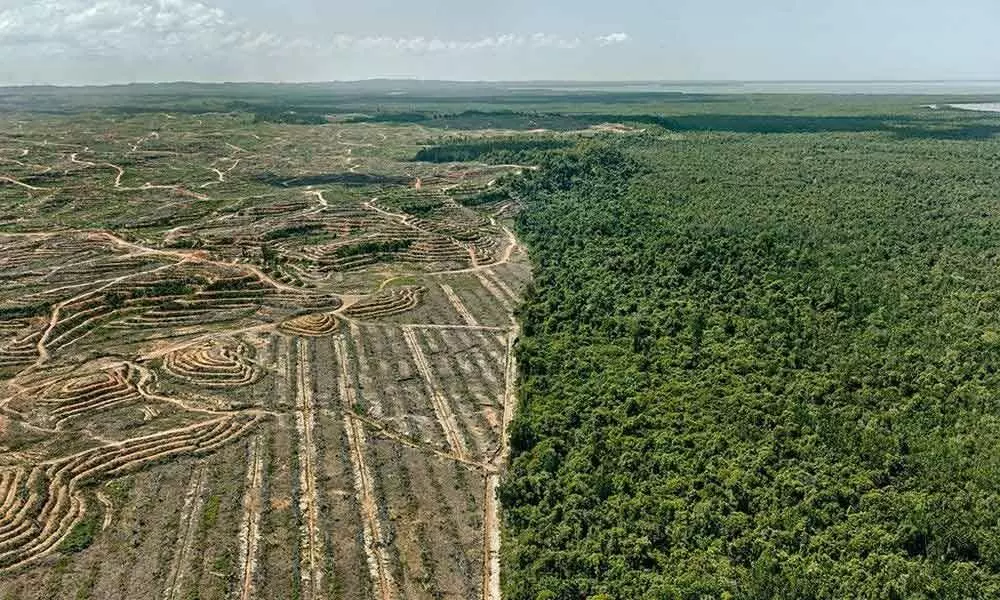India losing forest cover at a fast clip

India losing forest cover at a fast clip
Between 1950 and 1980, the country lost 4.3 million hectares of forest land and also the tree growth over it.
Between 1950 and 1980, the country lost 4.3 million hectares of forest land and also the tree growth over it. Half of the loss was attributed to development projects such as industries, mining, rehabilitation and agriculture and the remaining half was lost to encroachments.
The subject "Forests" was in included in the VII Schedule of Constitution of India in 1976 and, subsequently, the Forest (Conservation) Act, 1980 was promulgated to check the unprecedented deforestation across the country. The annual rate of deforestation which was 1,43,000 ha prior to 1980 was regulated under the Act and was brought down to 40,000 ha per annum.
All encroachments on the forest land till 1980 were regularised, but the matter did not end there, and fresh encroachments continued to take place. In September 1990, the Union government issued guidelines to States to evict all encroachments on the forest lands after 1980, but it was not complied with by any State. Even the Supreme Court in 2002 Godavarmana's judgement ordered to remove the post-1980 encroachments, but again the action on the ground was missing.
Pro-tribal NGOs and Left leaning liberals have continuously brought forth a narrative that injustice has been meted out to the forest-dwelling Scheduled Tribes and that their rights have been ignored, while processing the notification of forests.
To correct this injustice, The Scheduled Tribes and other Traditional Forest Dwellers (Recognition of Forest Rights) Act, 2006, commonly referred to as the Forest Rights Act, 2006, was promulgated. Even rules were notified on 31-12-2007 and the forest-dwelling STs and other traditional forest-dwellers (OTFDs) were entitled to the rights over the land to a maximum of 4 hectares in their occupation as on 13-12-2005.
While STs had to prove the occupation on this day, OTFDs had to prove 75 years of possession of forest land as on this cutoff date. Ministry of Tribal Affairs (MoTA) is the nodal agency for its implementation, which reviewed the progress with the States and issued advisories.
Even in States, social welfare/tribal departments were the nodal agencies, and the forest departments were left in lurch. At Gram Sabha level, forest right committees (FRC) verified the claims and sent them to sub-divisional level committee (SDLC) headed by sub-divisional officer of the revenue department, who after scrutiny referred the cases to the district-level committee (DLC) headed by District Collector for finally vesting the rights over the land to claimant or even rejecting the case.
The forest departments were represented in SDLC and DLC but were outshouted by the vocal political members of the committees. Usually, DLCs have accepted ration card and village elder's statement. Ration card cannot vouch for occupation of forest land and, moreover, the States have issued a large number of bogus ration cards to its people. Taking 75 years of occupation in respect of OTFDs into consideration, a village elder should have been adult in 1930 to certify the same.
Whenever the claims were verified with reference to satellite imageries, it was found that the tree growth existed on forest land on cutoff date i.e., 13-12-2005. Bogus claimants cleared tree growth and occupied forest land after the Act came into existence. The MoTA amended the rules in 2012 and said that the claims which were rejected relying on satellite imagery can be reopened and accepted if other evidences support it.
Satellite imagery provides scientific evidence and cannot be manipulated. But DLCs have gone on accepting the claims based on manipulated evidences. I was in contact with my friends in some of the States like Maharashtra, Madhya Pradesh, Chhattisgarh, Andhra Pradesh, Telangana and Odisha and compiled information received from these sources in a book I authored during the corona pandemic. The name of the book is 'Forest Rights Act – Accelerated Deforestation' which was published by Notionpress, Chennai, and can also be accessed through Amazon.
It lucidly brings out detailed accounts of processing and accepting large numbers of bogus claims. Forest personnel who offered resistance against it faced the wrath of politicians and were attacked by claimants. A large extent of fresh encroachments in Yawal Sanctuary of Jalgaon district and in Melghat forest of Amrawati district has gone unabated. Maharashtra has mastered the verification process of the claims through geo-informatics, using satellite imagery. Ineligible claimants, supported by powerful and vocal politicians, have strongly opposed it.
The nodal agency MoTA's masterstroke to make the forest department ineffective was to entrust the right of management of forests to rights holders. The role of the forest department has been sufficiently diluted in respect of management of community forest resources. Under the garb of management, forest personnel are kept out and incidents of wrongdoing are not reported. Smugglers and poachers make merry. Right to manage community forest resource was granted over 812 ha forest land in Gondia district in Nawegaon Nagjeera Tiger Reserve. This provision is at variance with the Wildlife (Protection) Act and has threatened the inviolate nature of the Tiger Reserve and its integrity.
There have been a number of press reports from many districts of Chhattisgarh in 2019, 2020 and 2021 that fresh felling of trees are in progress to occupy forest lands and claim rights for cultivation especially in the districts of Korba, Dhantari, Mahasamund, Ujaspur, Sarguja and Kabirdham. In one case, DLC Jaspur granted rights to an individual in 2017 over a land which had Sal forests of .8 densities. In November 2020, there has been complaint against Divisional Forest officer Sarguja that the illegal occupation of forest lands in Mahamaya Pahad, Ghutara Para, Khairabar, Badhiya Chua and Kulhadi villages are rampant.
In Madhya Pradesh Gaund, Baiga, Bhariyas, Korku, Bhil, Korwas, tribes are quite subdued and have not played aggressive role in destroying forests. However, Bhilala and Barela are two other tribal groups of the State, whose occupation is mainly agriculture. They expand it aggressively by clearing tree growth and making wildlife homeless. They migrate to other districts and undertake similar destruction of forests there. Internal assessment of the forest department has revealed that nearly one-third forests in Sendhawa, Barwani, Khargaon, Burhanpur, Dhar and Guna forest divisions have been impacted by the implementation of the Act. Reports in local press in 2018, 2019 and 2020 further add that plundering of these forests goes on endlessly.
In 2010, the combined Andhra Pradesh and Telangana had accepted claims over 5.86 lakh ha forest lands covering 1.7 lakh beneficiaries, which was increased to 55.79 lakh ha for 17.83 lakh beneficiaries in 2017. Thus, there have been deforestation over 5 million ha between 2010 and 2017 in both the States.
The implementation of the Forest Rights Act has caused maximum loss of forests in Maharashtra, Madhya Pradesh, Chhattisgarh, Andhra Pradesh and Telangana. Further, the Supreme Court has ordered for re-verification of claims rejected by DLCs, leaving the rejected claimants to continue to enjoy forest land. To prevent further deforestation, the government should at least fix a last date for filing claims.
(Writer is Former Principal Chief Conservator of Forests (Head of Forest Force), Karnataka)















